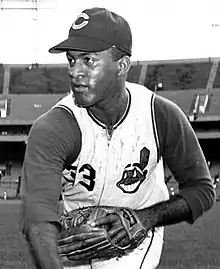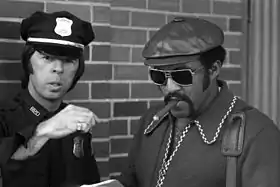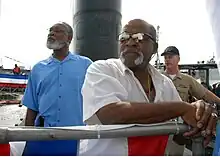| Luis Tiant | |
|---|---|
 Tiant in 2009 | |
| Pitcher | |
| Born: November 23, 1940 Marianao, Cuba | |
Batted: Right Threw: Right | |
| MLB debut | |
| July 19, 1964, for the Cleveland Indians | |
| Last MLB appearance | |
| September 4, 1982, for the California Angels | |
| MLB statistics | |
| Win–loss record | 229–172 |
| Earned run average | 3.30 |
| Strikeouts | 2,416 |
| Teams | |
| Career highlights and awards | |
| |
| Member of the Venezuelan | |
| Induction | 2009 |
Luis Clemente Tiant Vega (Spanish pronunciation: [ˈlwis ˈtjant]) (born November 23, 1940) is a Cuban former Major League Baseball (MLB) right-handed starting pitcher. He pitched in MLB for 19 years, primarily for the Cleveland Indians and the Boston Red Sox.
Tiant compiled a 229–172 record with 2416 strikeouts, a 3.30 earned run average (ERA), 187 complete games, and 49 shutouts in 3486+1⁄3 innings. He was an All-Star for three seasons and 20-game winner for four seasons. He was the American League (AL) ERA leader in 1968 and 1972. He also was the AL leader in strikeouts per nine innings pitched in 1967 and the AL leader in shutouts in 1966, 1968, and 1974.
He was inducted to the Boston Red Sox Hall of Fame in 1997, the Hispanic Heritage Baseball Museum Hall of Fame in 2002, the Venezuelan Baseball Hall of Fame and Museum in 2009, and the Baseball Reliquary's Shrine of the Eternals in 2012.
Tiant was considered for election to the National Baseball Hall of Fame via voting of the Baseball Writers' Association of America from 1988 to 2002, and by the Hall of Fame's era committees in 2011, 2014, and 2017, falling short of the required votes for induction each time.
Early years
Tiant is the only child of Luis Tiant Sr. and Isabel Vega. From 1926 through 1948, the senior Tiant was a great left-handed pitcher for the Negro league's New York Cubans during the summer and the Cuban professional league's Cienfuegos in the winter, his heroics being followed by hundreds of thousands of Cubans. Luis Jr. followed in his father's footsteps at an early age, joining both the local Little and Juvenile baseball leagues and rising to a star.
Cuba and Mexico
The 16 year-old Tiant was picked for the Cuban Juvenile League All-Star team in 1957. His talent drew the attention of former Cleveland Indians All-Star Bobby Ávila, who was scouting for talent in Cuba. Avila recommended him to the Mexico City Tigers of the Mexican League. Tiant was signed in 1959 for $150 a month, and for the next three years he divided his time between the Tigers and the Havana Sugar Kings in the International League.
Cleveland Indians system
At the end of the summer of 1961, and under Avila's recommendation, Cleveland purchased Tiant's contract for $35,000. But with the rise of Fidel Castro's regime in his native Cuba—specifically, after heightened tensions following the US-sponsored Bay of Pigs invasion in April of that year—it was impossible for Tiant to return home. He did not see his parents for 14 years.
Tiant progressed through the Indians' farm system beginning in 1962 with the Charleston Indians of the Eastern League, then with the Burlington Rangers—where he was one of the best pitchers in the Carolina League—in 1963, and lastly with the Portland Beavers of the Pacific Coast League in 1964. Tiant later recalled that at Charleston, "I couldn't speak very good English but I understand racism. They treated me like a dog, but when I got to Portland, I didn't have any problems."[1] After pitching to a 15–1 record at Triple-A Portland, which included a no-hitter and a one-hitter in consecutive starts, Tiant was called up by the Indians in mid-July 1964.[2]
MLB career
Cleveland Indians

On July 19, 1964, Tiant debuted in Major League Baseball for the Cleveland Indians with a four-single, 11 strikeout, 3–0 shutout victory against the defending AL Champion New York Yankees at Yankee Stadium, beating their ace, Whitey Ford. Tiant finished his rookie season with a 10–4 win–loss record, 105 strikeouts, and a 2.83 earned run average (ERA) in 19 games.
In 1968, Tiant had one of the greatest pitching seasons in major league history, leading the American League in ERA (1.60), shutouts (nine, including four consecutive), hits per nine innings (a still-standing franchise record 5.30, which broke Herb Score's 5.85 in 1956 and would be a Major-League record until surpassed by Nolan Ryan's 5.26 in 1972), and strikeouts per nine innings (9.22), while finishing with a 21–9 mark. His .168 opponent batting average set a new major league record, and his 19 strikeout/10 inning performance against the Minnesota Twins on July 3 set the American League record for strikeouts in a game. His 1.60 ERA in 1968 was the lowest in the AL in nearly half a century (since Walter Johnson's dead-ball era 1.49 in 1919), second only in the Major Leagues in that time to National Leaguer (St. Louis Cardinals) Bob Gibson's historic 1.12 the same year—the lowest mark ever during the live-ball era. And his four consecutive shutouts had been matched or bettered by only two other pitchers in the 50-year expansion era, both also in 1968: Don Drysdale (six) and Gibson again (five).
With Sam McDowell, Sonny Siebert, and others, the Indians staff led the AL in strikeouts for five consecutive years, including a record 1189 in 1967, a mark which would stand for 30 years.
Minnesota Twins
After an injury-plagued season with the Indians in 1969, Tiant was traded to the Minnesota Twins in a multi-player deal that brought fellow pitcher Dean Chance and third baseman Graig Nettles to the Indians. With Minnesota, Tiant began 1970 with six wins, but then he fractured his right scapula, essentially ending his season and, some felt, his career. He showed some promise in the 1971 spring training, but he was released.
Boston Red Sox

After being dropped by the Twins in spring training of 1971, the Atlanta Braves signed Tiant to a minor league contract to play with their Triple-A minor league Richmond team. Tiant began the process of reinventing himself as a pitcher by altering his delivery so that he turned away from home plate during his motion, in effect creating a hesitation pitch. According to Tiant, the new motion was a response to a drop in his velocity from his shoulder injury.[3] Twisting and turning his body into unthinkable positions, Tiant would spend more time looking at second base than he did the plate as he prepared to throw.
He pitched well in Richmond, and was acquired by the Louisville Colonels, a farm team of the Boston Red Sox. He was quickly called back up to the majors, but struggled through 1971 with a 1–7 record and 4.88 ERA. He regained his old form in 1972 with a sparkling 15–6 season in which he threw six shutouts in just 19 starts and led the league with a 1.91 ERA. He would win 20 games in 1973, and 22 in an All-Star 1974 en route to becoming known as El Tiante at Fenway Park, one of the greatest and most beloved pitchers in Red Sox history and an enduring idol in Boston.[4]
Though hampered by back problems in 1975, he won 18 games for the American League Champion Red Sox, then excelled in the postseason. In the playoffs he bested the three-time defending World Champion Oakland Athletics, allowing only three hits in a 7–1 complete-game victory, then opened the World Series against The Big Red Machine Cincinnati Reds. His father and mother were in Fenway Park that game to watch their son defeat the Reds 6–0 in a five-hit shutout,[5] having been allowed to visit from Cuba under a special visa.[4]
Tiant won Game 4 as well (throwing 173 pitches in his second complete game in the series) and had a no-decision in a Game 6 that has been called the greatest game ever played[6][7] (ending in a dramatic Carlton Fisk 12th-inning walk-off home run).
Tiant went 21–12 as an All-Star in 1976, 12–8 in 1977, and 13–8 in 1978, furthering his status as a fan favorite and one of the greatest pitchers in Red Sox history.[4]
New York Yankees
At the end of the 1978 season Tiant signed as a free agent with the Yankees.[8] He compiled a 21–17 record in New York over two seasons from 1979 to 1980.
Pittsburgh Pirates and California Angels
Tiant signed with the Pittsburgh Pirates as a free agent in 1981, pitching in just 9 games and going 2–5 with a 3.92 ERA. He also appeared in 21 games (all starts) for the Pirates' Triple-A Portland Beavers of the Pacific Coast League, posting a 13–7 record with 3.82 ERA.
He finished his career with a brief stint with the California Angels in 1982, pitching in 6 games and going 2–2 with a 5.76 ERA.
Other leagues
Tiant competed in the Venezuelan Professional Baseball League in parts of seven seasons spanning 1963–1982, while compiling a record of 37–24 including 29 complete games, a 2.27 ERA,[9] and a no-hitter in 1971.[10] He was a member of the champion Leones del Caracas teams of 1966–67 and 1967–68.[9] He gained induction into the Venezuelan Baseball Hall of Fame and Museum in 2009.[11]
Tiant competed in the Senior Professional Baseball Association in 1989, initially signing with the Winter Haven Super Sox.[12] He was subsequently traded to the Gold Coast Suns, in exchange for outfielder Ralph Garr and 500 Teddy Ruxpin toy bears (for use as a fan giveaway item).[12] Tiant had an 0–1 record with 5.00 ERA for the Suns.[12]
Post-playing days

Tiant was a minor league pitching coach in the Los Angeles Dodgers' farm system from 1992 to 1995, and in the Chicago White Sox's farm system in 1997.[13] During the 1996 Summer Olympics, he was the pitching coach for the Nicaraguan team.[13]
Tiant served as the head coach for the baseball team at the Savannah College of Art and Design, an NCAA Division III program, from 1998 to 2001,[13] where his teams compiled a record of 55–97 for a .366 winning percentage.
In 2002, Tiant was the pitching coach for Boston's Class A Short Season affiliate, the Lowell Spinners, and has continued to serve as a special assignment instructor for the Red Sox.[13]
Tiant, along with former batterymate Carlton Fisk, threw out the ceremonial first pitch before what proved to be the Red Sox' championship-winning Game 6 of the 2013 World Series at Fenway Park.[14]
MLB statistics
Tiant's major league stats:[15]
| Years | W | L | ERA | G | GS | CG | SHO | SV | IP | H | R | ER | HR | BB | SO | HBP | WP | BF | WHIP | ERA+ | WAR |
|---|---|---|---|---|---|---|---|---|---|---|---|---|---|---|---|---|---|---|---|---|---|
| 19 | 229 | 172 | 3.30 | 573 | 484 | 187 | 49 | 15 | 3,486.1 | 3,075 | 1,400 | 1,280 | 346 | 1,104 | 2,416 | 49 | 27 | 14,365 | 1.199 | 114 | 65.7 |
Hall of Fame candidacy
Tiant was on the National Baseball Hall of Fame ballot from 1988 to 2002, but peaked at 30.9% of the votes in his first ballot year.[15] According to election rules at the time, players were permitted on the Baseball Writers' Association of America ballot for a maximum of 15 years; in his 15th and final appearance on the ballot, Tiant received 18.0% of the vote during 2002 balloting.
Tiant was considered again for induction by the Hall of Fame's own Golden Era Committee (for the 1947–1972 era) in 2011 and 2014,[16] and by the Modern Era Baseball Committee (for the 1970–1987 era) in 2017,[17] but again fell short. The Golden Era Committee was replaced in July 2016 by a 16-member Golden Days Committee, to vote from a 10 candidate ballot for the 1950–1969 era.[18] The Golden Days Committee elected its first Hall of Fame members in December 2021 but Tiant was not among them.[19][18] Per changes announced to Veterans Committee processes in April 2022, Tiant could next be considered by the Classic Baseball Era committee (for personnel active before 1980) in their voting for the Hall of Fame's class of 2025.[20]
Personal life
Tiant and his wife, Maria, have three children: Luis Jr., Isabel, and Daniel.[13]
An avid cigar smoker, Tiant launched a line of cigars that he formulated and designed, branding them with his nickname, El Tiante.[21] Tommy John remembered Tiant's cigars only too well from their days in the Indians organization. "Luis would smoke these horrendous, long, Cuban cigars. We'd be on the bus all night, and wake up to a thick blue haze from Tiant's ropes. Tiant had an almost supernatural ability for keeping a cigar lit. Luis would cut up in his high-pitched voice, joking, cackling, and the eternal flame held true. He could even take a shower and keep his stogie going. In the confined space of a bus, the smoke would gag you. He'd fall asleep on the bus, but the cigar would somehow stay alive all night."[22]
Tiant appeared in an episode of Cheers, "Now Pitching, Sam Malone", which first aired on January 6, 1983. Sam Malone (Ted Danson) agrees to do a television beer commercial, co-starring with and "relieving" Tiant when the latter begins to fail in his promotion of the product.
Tiant has authored two autobiographies:
- El Tiante, the Luis Tiant story, written with Joe Fitzgerald, released in 1976[23]
- Son of Havana: A Baseball Journey from Cuba to the Big Leagues and Back, written with Saul Wisnia, released in May 2019[24]
Legacy
Tiant is the subject of the documentary film The Lost Son of Havana, produced by Kris Meyer and the Farrelly brothers, and directed by Jonathan Hock. The story of his return visit to his roots in Cuba had its world premiere on April 23, 2009, at the Tribeca Film Festival, and was promptly acquired by ESPN Films.
See also
References
- ↑ "The Legend Of Luis Tiant And The Final Chapter Of Baseball In Portland" Wendell Maxey, portlandsports.com, February 22, 2017
- ↑ "Cleveland Sends John to Minors; Tiant Gets Call". The Lima News. Lima, Ohio. UPI. July 18, 1964. p. 13. Retrieved September 3, 2023 – via newspapers.com.
- ↑ Cigar Insider: Luis Tiant of El Tiante Cigars
- 1 2 3 "Luis Tiant's Brilliant Career Landed Him On the Hall of Fame Ballot", Craig Muder, MLB.com
- ↑ Review of the "Lost Son of Havanna", Stealing Home, by Michael Judge, August 11, 2009 Wall Street Journal
- ↑ Remembering the Epic 1975 Red Sox vs. 'Big Red Machine' World Series, Bleacher Report, Zachary Rymer, May 6, 2014
- ↑
- Gammons, Peter. (1985). Beyond the Sixth Game: What's Happened to Baseball Since the Greatest Game in World Series History. Boston, Massachusetts: Houghton Mifflin. ISBN 0-395-35345-9.
- ↑ "Old foe Luis Tiant latest free agent signed by Yankees". Pittsburgh Post-Gazette. AP. November 14, 1978. p. 25. Retrieved May 30, 2010.
- 1 2 "Luis Clemente Tiant Vega". purapelota.com. Archived from the original on April 22, 2016. Retrieved July 31, 2019 – via Wayback Machine.
- ↑ Gutiérrez, Daniel; González, Javier (2006); Records de la Liga Venezolana de Béisbol Profesional. LVBP. ISBN 978-980-6996-01-4
- ↑ Salón de la Fama y Museo del Béisbol Venezolano Archived 2013-12-31 at the Wayback Machine (Spanish)
- 1 2 3 Clair, Michael (July 30, 2019). "An all-time great pitcher once got traded for 500 teddy bears". MLB.com. Retrieved July 31, 2019.
- 1 2 3 4 5 "Boston Red Sox Media Guide" (PDF). 2019. p. 444. Archived from the original (PDF) on December 15, 2019. Retrieved April 29, 2019 – via pressbox.athletics.com.
- ↑ Calcaterra, Craig (October 30, 2013). "Carlton Fisk, Luis Tiant to throw out the first pitch for Game 6". NBC Sports. Retrieved May 21, 2019.
- 1 2 "Luis Tiant stats". baseball-reference.com. Baseball Reference. Retrieved July 18, 2021.
- ↑ Abraham, Peter (December 9, 2014). "Tiant again denied a spot in the Hall". The Boston Globe. p. D2. Retrieved May 22, 2019 – via newspapers.com.
- ↑ "Former Tigers Morris, Trammell elected to Hall of Fame". Reuters. December 10, 2017. Retrieved May 22, 2019.
- 1 2 "Hall of Stats: Upcoming Elections". hallofstats.com. Hall of Stats. Retrieved July 12, 2021.
- ↑ Kelly, Matt (August 24, 2020). "Era Committee elections rescheduled to 2021". mlb.com. Major League Baseball. Retrieved July 18, 2021.
- ↑ "Hall of Fame Restructures Era Committee, Frick Award Voting". baseballhall.org. April 22, 2022.
- ↑ Nagy, Andrew (October 20, 2011). "El Tiante Cigars Return as a "Pepin" Garcia Blend". cigaraficionado.com. Retrieved May 21, 2019.
- ↑ John, Tommy; Valenti, Dan (1991). TJ: My Twenty-Six Years in Baseball. New York: Bantam. p. 61. ISBN 0-553-07184-X.
- ↑ Tiant, Luis; Fitzgerald, Joe (1976). El Tiante, the Luis Tiant story. Doubleday. ISBN 0385121164. Retrieved May 22, 2019.
- ↑ "'Son Of Havana' Luis Tiant On His Story On And Off The Field". WGBH-TV. May 16, 2019. Retrieved May 21, 2019.
Further reading
External links
- Career statistics and player information from MLB, or ESPN, or Baseball Reference, or Baseball Reference (Minors), or Retrosheet
- Red Sox' All-Time Team
- The Baseball Page
- Baseball Library
- Latino Legends in Sports
- Quotes from and on Tiant at Baseball Almanac
- Cooperstown Injustice: Why isn't Luis Tiant in the Hall of Fame?